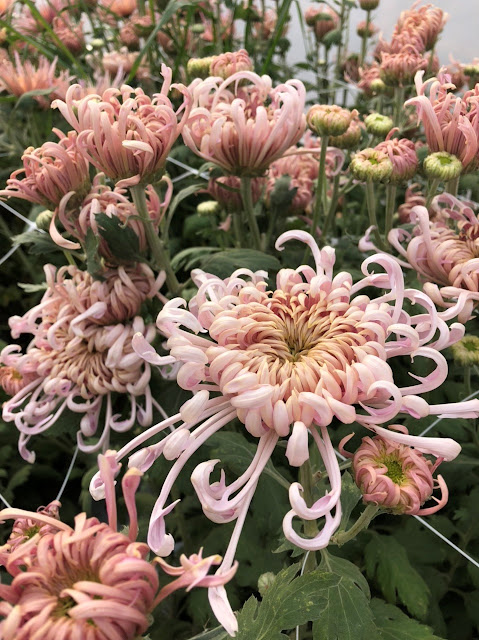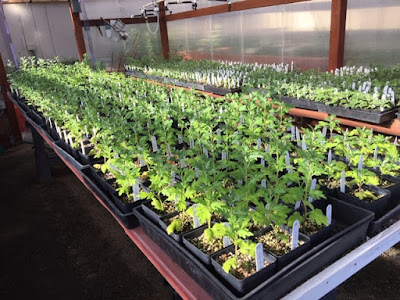

|
|
These Spider mum beauties are the Satin Ribbon variety. Find unusual mums
for sale Saturday at the Sacramento Chrysanthemum Society event. (Photos
courtesy Sharon Peterson)
|
It may only be early May, but it’s time to think about fall flowers – specifically mums!
What better place to stock up on chrysanthemums than the annual plant sale hosted by the Sacramento Chrysanthemum Society?
From 9 a.m. to 4 p.m. Saturday, May 8, find hundreds of rooted cuttings in dozens of hard-to-find varieties. The young plants will pack the Shepard Garden and Arts Center, but there will be lots of room for shoppers to spread out. Patrons are asked to observe COVID protocols; wear a face mask and stay socially distanced.
Planted now, these rooted cuttings will bloom in fall. As perennials, mums can come back year after year.
These young plants have been tenderly nurtured by local growers and should thrive in Sacramento area gardens. The society’s sale features varieties in every mum class, from the gigantic Irregular Incurves and cute Pompons to the feathery Quills and delicate Spiders. Colors range from purest white to darkest red, bronze or purple.

|
| These mums just about ready to be sold Saturday. |
Shepard Center is located at 3330 McKinley Blvd., Sacramento, in McKinley Park. Admission and parking are free.
Comments
0 comments have been posted.Sacramento Digs Gardening to your inbox.
Food in My Back Yard Series
April 22: Should you stock up on fertilizer? (Yes!)
April 15: Grow culinary herbs in containers
April 8: When to plant summer vegetables
April 1: Don't be fooled by these garden myths
March 25: Fertilizer tips: How to 'feed' your vegetables for healthy growth
March 18: Time to give vegetable seedlings some more space
March 11: Ways to win the fight against weeds
March 4: Potatoes from the garden
Feb. 25: Plant a fruit tree now -- for later
Feb. 18: How to squeeze more food into less space
Feb. 11: When to plant? Consider staggering your transplants
Feb. 4: Starting in seed starting
Sites We Like
Garden Checklist for week of April 27
Once the clouds clear, get to work. Spring growth is in high gear.
* Set out tomato, pepper and eggplant transplants.
* From seed, plant beans, beets, cantaloupes, carrots, corn, cucumbers, melons, pumpkins, radishes and squash. Plant onion sets.
* In the flower garden, plant seeds for asters, cosmos, celosia, marigolds, salvia, sunflowers and zinnias. Transplant petunias, zinnias, geraniums and other summer bloomers.
* Plant perennials and dahlia tubers for summer bloom. Late April is about the last chance to plant summer bulbs, such as gladiolus and tuberous begonias.
* Transplant lettuce and cabbage seedlings.
* Weed, weed, weed! Don’t let unwanted plants go to seed.
* April is the last chance to plant citrus trees such as dwarf orange, lemon and kumquat. These trees also look good in landscaping and provide fresh fruit in winter.
* Feed citrus trees with a low dose of balanced fertilizer (such as 10-10-10) during bloom to help set fruit. Keep an eye out for ants.
* Apply slow-release fertilizer to the lawn.
* Thoroughly clean debris from the bottom of outdoor ponds or fountains.
* Start thinning fruit that's formed on apple and stone fruit trees -- you'll get larger fruit at harvest (and avoid limb breakage) if some is thinned now. The UC recommendation is to thin fruit when it is about 3/4 of an inch in diameter. Peaches and nectarines should be thinned to about 6 inches apart; smaller fruit such as plums and pluots can be about 4 inches apart. Apricots can be left at 3 inches apart. Apples and pears should be thinned to one fruit per cluster of flowers, 6 to 8 inches apart.
* Azaleas and camellias looking a little yellow? If leaves are turning yellow between the veins, give them a boost with chelated iron.
* Trim dead flowers but not leaves from spring-flowering bulbs such as daffodils and tulips. Those leaves gather energy to create next year's flowers. Also, give the bulbs a fertilizer boost after bloom.
* Pinch chrysanthemums back to 12 inches for fall flowers. Cut old stems to the ground.
* Mulch around plants to conserve moisture and control weeds.